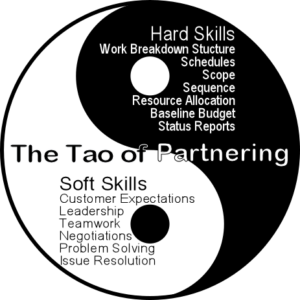Team Building Essentials – Eight Steps to Collaborative Partnering
 Step 1 – Create an Effective Atmosphere
Step 1 – Create an Effective Atmosphere
Pre-construction partnering sessions start with creating an effective atmosphere and is a critical step in the conflict resolution process. It is more likely for mutual agreements to be reached when the atmosphere and ground rules are given careful consideration.
Remember these ideas for team building, collaborative partnering:
- Personal preparation — ready yourself in positive ways to approach issues honestly and openly.
- Timing — choosing a time that is best for all parties involved. A time in which no one is feeling pressed to move on or pressured in other ways.
- Location — where you meet is as important as when you meet. It is best to pick a place where all parties can feel comfortable and at ease.
- Opening statements — try to start out on a good note. Good openings are ones that let others know you are ready and willing to approach conflict with a team-like attitude that focuses on positive ends. They should also ensure the trust and confidentiality of the parties involved.
Step 2 – Clarify Perceptions
Clarify individual perceptions involved in the conflict.
- Sort the parts of the conflict – ask what it is about.
- Avoid ghost conflicts — get to the heart of the matter and avoid side issues.
- Clarify what, if any, values are involved.
- Recognize that the parties involved need each other to be most effective.
Additionally, clarify your perceptions of the other party.
- Avoid stereotyping.
- Listen carefully; reflect what you think you heard.
- Recognize the other’s needs and values.
- Empathize – ask why they feel the way they do.
- Clear up misconceptions you may have of them.
Step 3 – Focus on Individual and Shared Needs
Pre-construction partnering sessions expand on shared needs. Realize that you need one another in order to successfully resolve conflicts. Be concerned about meeting others needs as well as your own. When you take the time to look, you will recognize that individuals often share needs in common.
Step 4 – Build Shared Positive Power
Power is made up of people’s outlooks, ideas, convictions, and actions. A positive view of power enables people to be most effective. A negative outlook on power proves disempowering. Instead of “power with,” it encourages “power over.” Positive power promotes building together and strengthening partnerships. When parties in conflict have this outlook, they can encourage each other to use shared positive power.
Step 5 – Look to the Future, then Learn from the Past
Don’t dwell on negative past conflicts, or you won’t be able to deal positively in the present or the future. Try to understand what happened in the past, and avoid repeating the same mistakes over. Don’t get stuck in a rut; learn from past conflicts and be forgiving. Let others know “I’m not mad at you, I’m mad at what you did.”
Step 6 – Generate Options
- Beware of preconceived answers.
- Look for common threads.
- Make sure options are workable for all parties involved.
- Set aside disagreements and focus on options that seem most workable.
- Avoid spin-off conflicts by bypassing options that won’t work for all involved.
In Generating Options:
1. Ask first for the conflict partner’s options — listen and learn.
2. Try free-flowing options:
⇒ make new suggestions
⇒ write them down
⇒ wait to discuss them till they’re all out on the table
⇒ group similar options together o narrow down the list
⇒ predict possible outcomes
⇒ look at all ideas, no matter how silly they may seem
⇒ Imagine
3. Identify Key Options; these are ones that will:
⇒ meet one or more of the shared needs
⇒ meet individual needs and are compatible with other’s needs
⇒ be at least acceptable but preferably satisfying to all involved
⇒ improve the relationship
⇒ use mutual positive power
4. When looking at options, don’t let past experiences cloud present perceptions and decisions.
Step 7 – Develop “Doables” —
Stepping-Stones to Action
Doables are specific actions that have a good chance at being successful. Doables are:
- the ideas that have the best chance at success
- steps that never promote unfair advantages on any sides
- found on shared input and information from all parties
- trust builders – they add confidence in working together
- actions that meet shared needs
Step 8 – Make Mutual Benefit Agreements
Pre-construction Partnering Sessions provide Mutual-Benefit Agreements should give you lasting solutions to specific conflicts.
- Instead of demands, focus on developing agreements and find shared goals and needs.
- Build on “Doable” things by working on the smaller stepping-stone solutions.
- Pay attention to the needs of the other person in addition to your own interests.
- Recognize the “givens” – basic things that cannot be altered or compromised.
- Clarify exactly what is expected of you in the agreement – your individual responsibilities.
- Keep the collaborative partnership process going by using and sharing these skills with others.